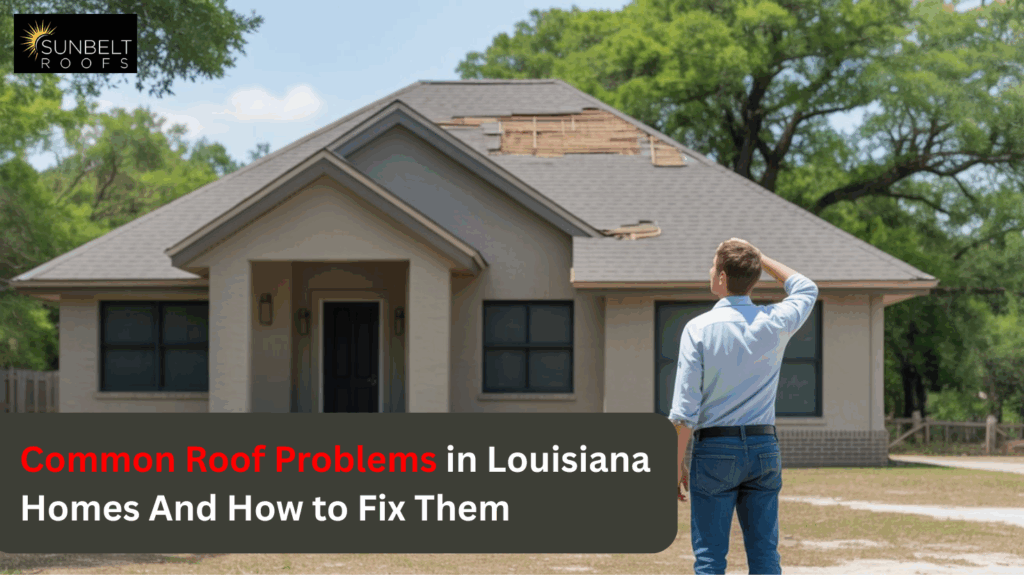
In Louisiana and Mississippi, roofs face much more than normal day-to-day damage. Summer heat, excessive moisture, tropical storms, hurricanes, and continuous rain batter the shingles and underlayment. Because of that, knowing the most common roof problems and how to stop them is vital for local homeowners.
At Sunbelt Roofs, we have repaired almost every roofing headache our sticky climate can throw. In this guide, we outline the eleven common roof problems we see most often on Louisiana houses and show you simple steps to keep your roof healthy for years.
List of the Most Common Roof Issues We See in Louisiana Homes
1. Leaky Roofs
Roof leaks rise to the top of our call list when storm season rolls around. Why? Our area can soak up over sixty inches of rain every year, and once that moisture slips under the shingles, it can wreck ceilings and walls in a matter of days.
– Cracked or missing shingles
– Rotted or loose flashing around chimneys and vents
– Torn or worn roof valleys
– Clogged gutters that trap water and overflow
The warning signs may not be banging on a drum light stains on ceilings, musty smells, or drippy light fixtures are often the quiet first hints of trouble.
Tip: Book free routine roof checkups with trusted Louisiana roofers to spot small leaks before they grow.
2. Missing or Damaged Shingles
In Louisiana and coastal Mississippi, hurricane-level gusts can blast past 70 mph and tear shingles loose.
A missing shingle opens the underlayment to rain, sun, and UV wear. Even a handful gone can weaken the whole roof.
After many humid summers, old asphalt shingles may curl, crack, or split from relentless heat.
3. Roof Blistering
Blistering happens when damp air trapped below shingles or membrane boils, forming bubbles that later burst. On Louisiana afternoons above 95°F with stifling humidity, the roof gets hot enough for this damage, one of the common roof problems in our region, to spread quickly.
Popped blisters thin the shingles and weaken waterproofing, leaving your roof open to rot and leaks.
4. Ponding Water
Many Louisiana homes feature flat or low-slope roofs, and rain can pool in shallow dips instead of draining.
During heavy rains in our state, standing water on the roof can:
– Break down shingles and flashing material
– Put extra weight on the rafters
– Push leaks through hidden weak spots
Routine yearly checkups, plus the right slope and drains, can cut down on this issue for Louisiana houses.
5. Cracked Flashing
Flashing thin metal bands around chimneys, skylights, and vents keeps rain from slipping inside. After countless summers and storm gusts, that metal can bend, crack, or pop loose.
Once cracked, flashing quickly turns into a top leak source, inviting water where you least expect it.
6. Roof Ventilation Problems
Too little airflow lets Louisiana and Mississippi attics bake like ovens, trapping heat and moisture that cause:
– Mold and mildew growth
– Wood rot in the rafter
– Shortened roof lifespan
– Sky-high energy bills as your AC struggles.
If the upstairs feels muggy or you spot mold in the attic, call a professional roofing contractor to check the vents.
7. Damaged Roof Valleys
Roof valleys, the V-shaped channels where two slopes meet, move huge amounts of water off the roof fast.
In our region, piles of leaves, twigs, and storm junk collect in roof valleys, and it is one of the most common roof problems. After a while, the trapped water rots wood, ruins shingles, and leaks straight into your living space.
8. Tree Damage
Southeast neighborhoods boast grand oaks and tall pines, but those same giants can threaten roofs:
– Low branches scrape or pierce shingles
– Heavy limbs snap in storms and crush roofing
– Dropped leaves clog gutters and jam valleys, backing up water
Tip: Trim trees regularly and clear debris after every big storm.
9. Gutter Issues
Working gutters shield roofs from leaking. If they plug, rust, or break, water slips under shingles or spills over your siding and foundation.
In a state known for tropical downpours, clean, tuned gutters are a quick, smart way to dodge leaks.
10. Sagging Roofs
A sagging roof is a very common roof problems, and it warns homeowners that something is very wrong-yet we still find the problem in many aging Louisiana houses.
A roof that sags might suffer from any of these issues:
– Water-soaked decking
– Weak or rotted framing
– Overall, poor roof design
– Long-term puddling on the roof
If you spot dips or low spots, call a roofing contractor right away to keep your house from losing its roof.
11. Storm and hurricane damage
Storms and hurricanes rank high among the roof troubles we see in Louisiana. Wind over 100 mph or flying debris can batter even the newest, best-kept roofs.
After a storm, roofers often find:
– Uplifted or torn shingles
– Bent or broken flashing and gutters
– Small punctures
– Cracked or snapped rafters
Tiny dents or tears that look harmless today can grow into leaks tomorrow, so a fast, professional post-storm check by an experienced roofing contractor in Louisiana is always the smart move.
How to Stop Common Roof Problems in Louisiana and Mississippi
Taking a few easy steps can shield your roof from trouble:
– Schedule roof checks twice a year and right after big storms
– Keep gutters clean so water flows freely
– Trim branches so trees stay clear of the roof
– Watch for water stains or peeling paint inside
– Don’t let a missing shingle sit and call for repairs fast
Team Up with Roof Pros in Louisiana and Mississippi
At Sunbelt Roofs, we have helped folks in Louisiana and Mississippi guard their biggest investment for years. Whether you need
– Quick roof fixes in Louisiana
– Metal or tile roof installs
– Hurricane damage reviews
– Comprehensive roof inspections
We have got you covered. As a local contractor, we know what our weather puts roofs through, and we back every job with a 25-year labor warranty. Call Sunbelt Roofs now for your FREE roof inspection and make sure your home is ready for whatever the Louisiana skies bring next.
